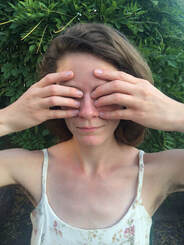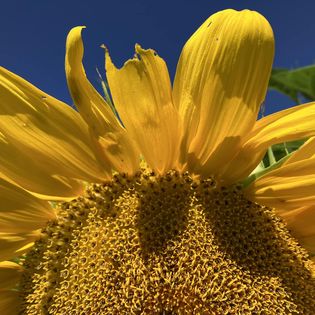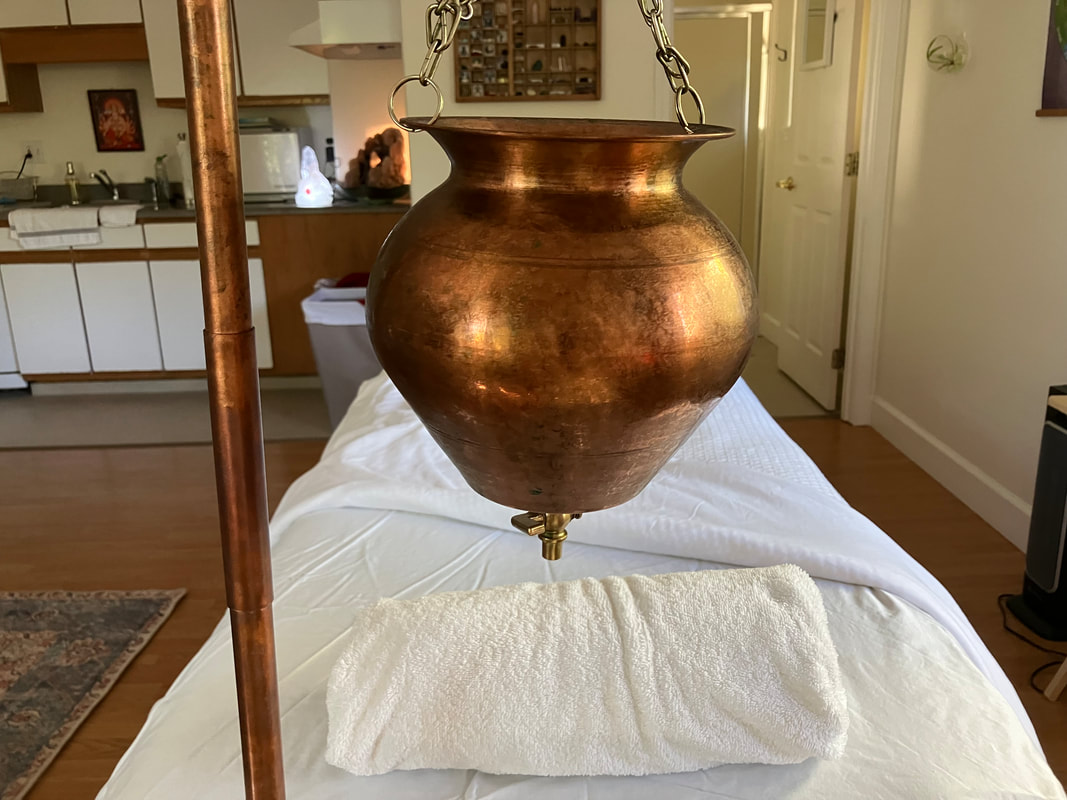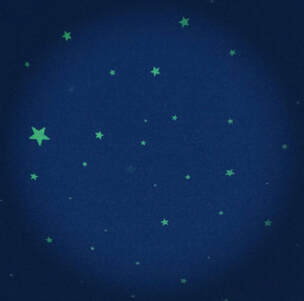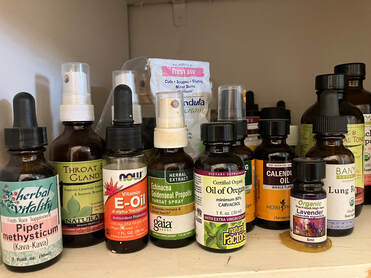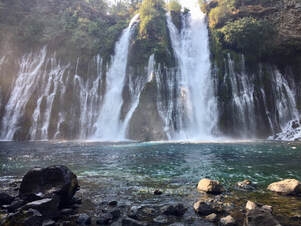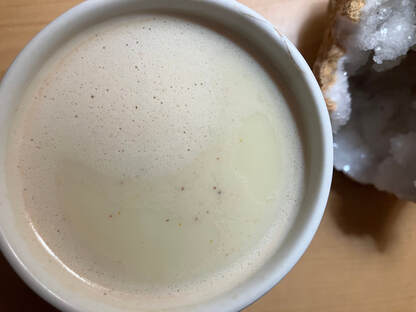|
Ayurvedic Pranayama techniques offer us the tools to prevent stagnation, maximize our breathing potential, and connect to our vital life force, or prana; the pulsation of cosmic consciousness. The translation of prana from Sanskrit, means “that which travels well”, however it is a force we can only perceive through experience. Pranayama are exercises to restore and purify not only our physical bodies through the respiratory system, but also our energetic and emotional bodies. Join Beverly Foster, Ayurvedic Practitioner and 500 hour Ayurvedic Yoga Instructor, in learning the tools and techniques of Dr. Lad’s Ayurvedic Pranayama set so that you may be empowered with your connection to breath to flourish in your everyday life.
In this set, you will acquire the tools and techniques to learn breathing exercises, including those specific for balancing your doshas (vatta, pitta, kapha). Dr. Lad, renowned Ayurvedic Physician, has a specific set of 8 breathing exercises to incorporate into your day. These breathing techniques target not only your respiratory system, but also specific organs to increase oxygen, remove physical and mental blockages, and nourish your deeper cells for optimal connection with mind, body, and spirit. Learn the full set as well as which ones you can pick and choose to include in your daily routine to support your unique doshic state. Incorporating these pranamaya into our dinacharya, daily routine, profoundly supports our physical and energetic healing. Ayurveda, the Science of Life, teaches us that our daily routines are pivotal to our overall health and wellbeing to live healthy and happy lives. Join us in learning these breathing exercises to use in your personal routine and reflect on the power of your breath. Together, we will collectively nourish and heal our bodies, one breath at a time.
0 Comments
As a child, my mom was sick and used Ayurvedic practices to increase the quality and quantity of her life. She taught us the power of thought, meditation, yoga and eating well, encouraging compassion, humility, and a respect for all beings. She incorporated Ayurvedic principles and techniques into our diet and daily lives. She read Dr. Lad’s book, Ayurveda: The Science of Self-Healing which is full of her highlighter and pencil markings. This book is one of my most sacred possessions. I recently found a recommendation form from an Ayurvedic consultation she received in the early 90s; the herbs, asana, and pranayama techniques are ones I now recommend to clients and have studied extensively. She was a pitta/kapha constitution.
In college, I studied sacred text of Eastern Religions including Ayurvedic and Vedic text. I taught workshops and lectures on Ayurveda and immersed myself into the tradition of Vedic culture through sacred text. I learned a lot about herbs from a local Gullah man who owned a herb shop down the street from me in Charleston, SC. He had all kinds of majestic jars full of dried and powdered herbs. When I would visit him, he would talk my ear off about comfrey, dandelion, peppermint, mullein, and I loved every minute of it. Something felt so familiar and intriguing about his herbal apothecary. After college I lived on an alternative medicine herb farm in the Appalachian mountains of North Carolina. I was the apprentice to a master herbalist and acupuncturist. She spent hours mentoring me on alternative and herbal medicine, teaching me about how we are all unique representations of the qualities found in the elements. She encouraged me to sit with a herb and meditate on what it has to say to learn how it can heal. These herbs were allies and friends; I had a unique relationship and understanding with each one. She was a huge support to me and encouraged me to follow my dreams. We grew Ayurvedic, Chinese, & Western herbs and it was on this land I realized my path was with alternative and herbal medicine. When I moved to Ashland over ten years ago, I worked for Ayurvedic Rasayanas making traditional Ayurvedic medicine. Mixing, blending, and compounding herbs further solidified my experience and deepened my existing knowledge and love of Ayurveda and Ayurvedic herbs. It was a tremendous learning opportunity. When visiting the National University of Natural Medicine in Portland for a job opportunity, the Apothecary Manager at the time encouraged me to seek formal training. My fire was lit and I knew studying directly with Dr. Lad was the next step. Guided by something greater than myself, I was accepted to The Ayurvedic Institute where I studied for three years. One of my mom’s dreams was to visit Albuquerque and I pondered this while driving to the desert from Oregon. I completed the Ayurvedic Practitioner clinical program and 500 hour Ayurvedic Yoga teacher training. I stayed an extra year to work as one of Dr. Lad’s herbalist for his practice, attending all of his seminars and retaking as many classes as they would let me. Since arriving back to Ashland five years ago, I have been through a period of growth, working as an herbalist and Apothecary Manager for a local cancer clinic for a couple of years and now working with Banyan Botanicals, an Ayurvedic Herb company. I have been finding my groove with what it means to practice and embody Ayurveda. I am so deeply honored to have the opportunity to work with Siskiyou Ayurveda and establish my personal practice, Shine Ayurveda. Our intention is to carry on the legacy of Dr. Lad. I am fulfilling a life long dream to share this profound wisdom to support others on their own unique healing path. We are a community of light. To celebrate our differences and uniqueness is one of the many beauties of this ancient medical science. I like to think my mom would be proud knowing what an impact her own relationship with Ayurveda has had on my life path. Ayurveda is something so deeply connected to my being. The saying “the more you learn, the less you know” has never resonated more than when it comes to the study of Ayurveda. It is ever evolving and growing and truly teaches us to be the best beings of light we can be on this earth. Rasayana Therapies in Ayurveda are essential to the quality and quantity of our lives.
In preparing for a lecture I am giving on rasayana therapies (rejuvenation therapies) and traditional preparation of herbal chyavanprash, I have been reflecting on what rasayana means to our current culture. While much of the material I am researching is directly from the ancient text of Ayurveda, including Charaka Samhita and the Ashtanga Hydram, we can relate rejuvenation therapy and techniques to our current world. Much like anything from Ayurveda, we can benefit from this ancient healing modality in our everyday lives. Rasayana (rasa meaning juice, nectar, essence & ayana meaning path) literally means “the path of juice”. A rasayana can be any herb, therapy, or substance that deeply nourishes our tissues. While tonics in Ayurveda are building and nourishing, rasayanas go even deeper, nourishing the ojas (vitality) of our whole being and balancing pineal gland secretions that have a direct impact on the length, quality, and health of our lives. Some might say that Ayurveda as a medical science was founded on the desire of ancient people from Vedic times to promote longevity, a main goal of rasayana therapy throughout time. While herbal medicine is important in rejuvenation therapies, meditation and pranayama medicine (breathing exercises) are key components. To increase the quality and quantity of life, one must take to heart the power of personal integrity in mind and action to keep ojas strong and our tissues nourished. Typically, rasayana herbs and formulations are given after cleansing measures have already been taken, however meditation and pranayama can happen at any stage of therapy to receive benefits. Vaghbhat says that “Those who speak the truth, who never become angry, who lead a spiritually pure life and are always serene are considered to be rejuvenated daily.” We can call this “behavioral rasayana”. Dravya rasayanas are typically substances that are nourishing, grounding, heavy, and oily; however the substance can take any shape or form and depends on the state of health of the patient and their doshas involved, more specifically the qualities (gunas) from the doshas that need to be balanced. For example, some kapha rasyanas are heating, light, and pungent. Chyavanprash, a famous rasayana, is a type of avaleha (or sweet paste). In our class, we will make a batch of chyavanprash, blending together available herbs that are from the traditional recipe of Charaka, boiling amla fruit, the catalyst for this nutritive jam, frying the fruit in ghee and oil and making a past with bamboo extract, ghee, honey, and saffron, all ingredients Charaka describes that prolonged the great sage Chyavan’s life in ancient times. Here are some accessible rasayana chikitsas you can practice in your day to day life to promote health and longevity: 1) The power of positive thinking. The more we shift our thoughts for the positive we are actually increasing our vitality. Think of the qualities of thought. Anger is heating, sharp, and light. Contentment and peace is cooling, calming, and soft. These qualities affect our cellular metabolism and influence our whole bodily digestion, absorption, and assimilation of nutrients and energy. 2) Shirodhara treatments. Shirodhara is when a stream of oil is continuously poured over your third eye, deeply nourishing the nervous system and promoting cellular repair. As both a purifying and rejuvenating therapy, shirodhara targets the central nervous system, decreasing stress and fatigue. 3) Foods and herbs. Some of my personal favorite rasayana herbs are: brahmi, ashwagandha, pippali, amalaki, and aloe. Ghee and honey are also rejuvenating substances. It is best to work with a practitioner to discover what herbs would be appropriate for your dosha, however, things that soothes your soul and body can certainly be a potent rasayana! We know our bodies best. Our culture is so hyper focused on success and productivity that in many ways we forgotten the value of rejuvenation therapy. So the next time you are sitting quietly outside, or taking a deep breath before moving forward with your day, or perhaps resting on the couch, remember you are taking part in an ancient form of healing that is replenishing for your body and mind! Happy Nourishing! In a sense, the art of Ayurveda is the art of observation. As an Ayurvedic Practitioner, I (Beverly) take a look and observe a few key parts of the body to get an idea of the imbalance that is potentially occurring in my client. From pulse reading to tongue diagnosis to observing lines on the face, our internal bodies speak through an external expression.
When we examine the body externally to gather information on internal imbalances, we use the three categories of clinical examination (trividha pariksha) which are: darshanam (visual observation), sparshana (touch examination), and prashna (questioning). Tongue diagnosis falls under the category of darshanam, visual observation. Parts of the tongue are directly related to different organs. In tongue diagnosis, we examine the texture, quality, shape, color, size of the tongue. For example, we can see congestion in the intestine portion located in the back center portion of our tongue. If we see a white coating here, typically there is ama (toxins) in our colon and we would want to focus on increasing agni (digestion) and removing toxins with herbal support such as triphala. Triphala is a wonderful blend of three fruits, amalaki, bibhitaki, and haritaki. This blend is specific for improving assimilation and digestion as well as a gentle detoxification. Scraping our tongue in the morning as a part of our daily routine removes toxins from the tongue. The qualities of the doshas can also be seen in tongue diagnosis. Red typically indicates a pitta imbalance while white or “froth” is a sign that kapha like qualities have increased in the form of phlegm to protect the tissues. Vata can be observed by a “quivering” tongue or cracks that typically indicate chronic vata derangement in the colon or cells. Taking this information and applying it to your personalized protocol is key in an Ayurvedic consultation. To schedule a consultation, please email Beverly at [email protected] Handing out samples of Banyan Botanicals' Chyavanprash and new Turmeric Honey and Elderberry Honey at our local Coop! Grateful to work for a company that truly values quality.
Fairly Traded. Certified Organic. Sustainability Sourced. 🌱 If you dream a little or a lot, if you dream in black and white or vivid colors, our dreams can say a lot about our current doshic imbalance or even a cry for help from certain organs. Naturally, different dreams can be indicative of their doshic nature. During consultation, your practitioner may ask you about dreams and your dream state. Let us take a deeper look on what that means and how we can identify doshic imbalances in our dreams.
Vata type dreams are of flying, the feeling of fear, feeling trapped or attacked. Gas and bloating are a typically a vata imbalance in the digestive system. The sense of flying comes from the increased air quality moving around in our bodies, specifically in the digestive system which can indicate constipation. This creates the sensation of movement. Vata type dreams tend to be active with many types of dream activity and movements. Pitta dreams tend to be violent, fiery, or include problem solving. Pitta is intelligent in nature and in pitta type dreams, the concern for being on time, intellectual conversations, or dreams of study may show up. Dreams of violence or fire is a strong indication of high pitta and the hot quality in the stomach and general heat in the body should be reviewed. Pitta individuals respect the appropriateness of their appearance and may have dreams about not being dressed properly in the case of a pitta out of balance type dream. Kapha type dreams are sweet, beautiful, and romantic. Dr. Lad describes kapha dreams as “romantic, with maybe a lake and lotus flowers and beautiful swans or ducks” (Textbook of Ayurveda: Volume 2, pg. 168 Dr. Lad). As kapha is comprised of earth and water, kapha type dreams are watery and fluid. Dreaming of drowning can indicate a urinary tract imbalance or fluid in the lung. While we can certainly look at dreams from a physical perspective, we cannot forget the importance of the spiritual connection in our dreams as our minds processes our surrounding world. What is in your medicine closet? Is it actually medicine? Many of the products that are sold these days contain harmful chemicals. From makeup, to supplements, to creams, we are taught to trust what is on the shelves yet it is important to be cautious when buying "wellness" products.
I am grateful I live somewhere I have access to organic, sustainable, and clean products. As an herbalist, I know first hand how herbs, many that grow in our own yards, can offer the same support and healing that synthetic "medicine" can. A few staples I keep in my medicine cabinet are calendula cream, throat sprays and bronchial syrups, lavender essential oil, bentonite clay, rubbing alcohol, and antiviral herbs like oregano. Bentonite clay is my go to for any splinters, bites, or stings. When used externally, it helps to pull out poisons and small particles. If you get a mild burn from cooking, immediately apply lavender essential oil. I have seen blisters develop and disappear after application of lavender. Any onset of a scratchy throat or when traveling, throat sprays containing goldenseal and propolis protect our immune system to keep away colds and the flu, especially going into fall and winter. The more that I talk with people about their state of wellbeing, I realize how pivotal it is for Ayurveda to shine at this point in history. I also realize, many are not familiar with Ayurveda and what it actually is. How can we use this incredible ancient healing modality in our current time in history? What exactly is Ayurveda and how can we apply this to our daily lives? What is my dosha and unique expression of the elements? I find that it is important to go back to the basics so we can truly grasp an idea of what Ayurveda is and how we can use this ancient science as a tool for our health and wellness.
Ayurveda is the science of life, the science of self-realization, and the knowledge of life. Ayur means life and Veda means knowledge/truth/or science. Dating back to 5,000 years ago, the first written expression of Ayurveda can be found in the Artharva Vedic text from 1,500 BCE that mentions 125 botanical plants and their healing properties. Of course, Ayurveda existed as an oral tradition well before written text. One interesting thing to note about Ayurvedic texts is the physicians, whom were seers cognizing this knowledge, edited and expanded upon previous written text based on experiential trial and error. Therefore, Ayurveda is both traditional and experimental in nature. Ayurveda also acknowledges that one size does not fit all. We are all unique expressions of the elements and embody a constant flow of balance and imbalance from environmental, emotional, and diet-based factors. Ayurveda approaches healing from a truly holistic perspective, embodying mind, body, and spirit. As the soul of Ayurveda is held in a deeply cultural and ritualistic tradition, you cannot practice Ayurveda without taking into consideration the spirit of existence. The root of Ayurveda is held in Sankhya Philosophy, or a creation philosophy, that describes the journey of consciousness into matter. We are all in a state of illusion that we exist solely as our functioning bodies, yet we are much more connected to the cosmos then we think. So, in Ayurveda we really seek and value self-realization to fully understand ourselves as a whole being observing and existing in the world. The three doshas, vata, pitta, and kapha, are the “humors” comprised of the five elements in our bodies. We all have these three doshas circulating within us, however the quality and quantity of each varies. Vata is ether and air. Pitta is fire and water. Kapha is water and earth. Dosha is best translated as “organization” because when in balance, or organized properly with our prakruti (unique constitution) we are in a state of health. When they become out of balance, vikruti, we are in a state of imbalance or di-ease. This can show up in our mental, emotional, or physical beings. The true goal is to get back to the state of our prakruti so that we are happy and healthy. Vata individuals are typically slender and love to move. They are creative, adaptable, enthusiastic and love change. Vata type individuals tend to furiously spend money, particularly at the thrift store as they love old antiques. They typically wear bright colors and mismatching patterns. They are artistic and have a true joy for life. When out of balance, a vata predominate individual will be fearful, anxious, nervous, forgetful, spacy and will be prone to vata digestion such as constipation and bloating. Nourishing and grounding tools are necessary to get vata back to balance. Pitta individuals have a moderate body built with well-defined muscles. They may have many freckles and moles and are fiery in appearance and personality. Pitta types are extremely intelligent, ambitious, passionate, and organized. When out of balance, pittas can be judgmental, angry, jealous, and unyielding. Heat in the body is a sign of high pitta. Serenity and cooling practices are best for a pitta who is out of balance. Cooling foods such as cilantro, lime, coconut will help to keep a pitta cool, calm, and collected. Kapha individuals have large, beautiful eyes and thick lustrous hair. Kapha types are more prone to carrying extra adipose tissue on their body and tend to have slow, steady movements. Kapha personalities are welcoming, loving, forgiving, and caring however can become attached, depressed, or possessive when out of balance. Energizing, stimulating, and warming foods and practices are best to keep kapha motivated and moving. Summertime means pitta season. With climate that is hot and dry, or hot and wet, there are many Ayurvedic tools we can use to remain cool, calm, and collected to beat the heat and stay balanced.
According to Ayurveda, each season holds qualities that represent the different Doshas. Summer represents pitta. The qualities of pitta, which is ruled by water and fire, are: hot, sharp, light, liquid, spreading, oily, and sour. While the main home site of pitta is the small intestine, pitta also lives in the stomach, eyes, blood, liver, sweat, grey matter of the brain, and sebaceous glands. The more we can understand how pitta shows up in our bodies, the better we can mitigate any imbalance during the hot, summer days. Whether you are predominately vata, pitta, or kapha, our surrounding environment can off balance our physical and emotional bodies and increase our Doshas. For the summertime season, the heat can increase pitta and show up as anger, heat in the body, irritability, confusion, rash, hives, inflammation, gastrointestinal issues, diarrhea, or fatigue. It is important to stay hydrated so that our red blood cells are saturated enough to absorb the liquids and easily circulate throughout the body. Now let’s talk about some tools to stay cool. While drinking water is important to stay hydrated, sometimes too much water can deplete the lining of our red blood cells and pass right through us. Electrolytes are important to support the absorption of water into our red blood cells, however many brands on the market have tons of sugars and other ingredients that are not so great for us. Consider this very simple, yet profoundly hydrating, electrolyte drink. In a 34 ounce cup, add ½ squeezed lime, a pinch of any sugar and salt you have, and BOOM! You have yourself an amazing electrolyte beverage to drink throughout the day. Drink one, every day. Herbs play an amazing role in supporting our physical and mental well-being too. Brahmi is an incredible herbal ally during summer days. Pitta rules intelligence, and Brahmi works on the mental brain to promote tranquility and awareness, while also nourishing the nervous system. The properties of Brahmi are sweet and bitter, with a cooling energy, to keep the mind cool and levelheaded. The main action of Brahmi is on the brain while also promoting a cooling and stress releasing effect on the nervous system. Lastly, pranayama, or breathing exercises, can be an immediate tool to cool off. Sheetali literally means “that which is cooling”. Sheetali is used not only to cool down anger or irritability, it also targets the stomach and gastrointestinal lining to ease peptic ulcers or gastritis. Here is a link to instruction on how to do Sheetali. Learn to beat the heat with Sheetali Did you ever combine the most outlandish ingredients together when you are a kid? Whatever spices you could get your hands on, leaves, strings, shells, obviously poisonous berries, flowers, sand. You name it.
Years later, as an adult and an herbalist (go figure), I still find excitement and magic in blending ingredients into potions. A blend that has been a staple in my life for years is in a milk base. Traditional preparation of milk decoctions are called ksirapaka kalpana. 1 part herb, 8 parts milk, and 32 parts water are simmered together. Nourishing and grounding, my personal take on ksirapaka kalpana is something I have been enjoying as a nighttime treat. Some herbal constituents are oil soluble and offer the nourishment needed to pacify vata and cool pitta. Extracting the lipid soluble parts of the plant can make the healing properties more bioavailable. You can use cow’s milk or any milk alternative for making a tasty treat. In Ayurveda, an anupana is a carrier for the herbs to different places or organs in the body. Blends with milk as a base helps to pacify pitta and nourishes the nervous system. Adding ghee to the warm beverage helps the herbs navigate to deeper tissues of the nervous system (majja dhatu) and reproductive system (artava and shukra dhatu). I am going to share with you one of my secret potion recipes. While you may not have all of these herbs available, I encourage you to play a little and add spices in your cabinet that feel right. I hope you enjoy this tasty treat as much as I do! 1/4th Teaspoon Shatavari 1/4th Teaspoon Ashwagandha 1/8th Teaspoon Arjuna 1/8th Mucuna Pinch of Pippali (you can use black pepper instead) Sprinkle Moringa Sprinkle of Nutmeg Sprinkle of Cinnamon Sprinkle of Cardamom Sprinkle of Turmeric 1/2 of ghee after hot beverage is in mug Sip, and enjoy! |
Beverly's BlogArchives
September 2023
Categories
All
|
850 Siskiyou Blvd, Suite 3 Ashland, OR
[email protected] : (803) 446-4331
[email protected] : (803) 446-4331
